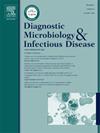CLIA immunoassay as an alternative and accurate method to detect Sars-Cov-2 antigen compared to ELISA
IF 2.1
4区 医学
Q3 INFECTIOUS DISEASES
Diagnostic microbiology and infectious disease
Pub Date : 2025-04-03
DOI:10.1016/j.diagmicrobio.2025.116828
引用次数: 0
Abstract
Background
COVID-19 has caused moderately severe infections in humans over the past few years, leading to >759 million confirmed cases. This situation highlights an urgent need to develop accurate diagnostic tests to monitor infectious disease and to adopt alternative methods such as CLIA to achieve low detection levels of proteins on diagnostic platforms.
Objectives
Develop in-house immunoassay for ELISA and CLIA to diagnose COVID-19.
Methods
200 nasopharyngeal samples were collected using swabs, placed in tubes with 3 mL of PBS. 1 mL from each sample was used to perform qRT-PCR and was considered positive in samples with CT < 38. The remaining volume was used for in-house sandwich immunoassay ELISA and CLIA.
Results
The results showed that CLIA was able to detect active disease in samples containing N protein concentrations greater than 16 ng/mL, with a sensitivity of 90 % and specificity of 94.5 %, and an area under the ROC curve (AUROC) of 0.943 (95 % CI: 0.909–0.977). ELISA showed an AUROC = 0.709 (95 % CI: 0.639–0.778), with a sensitivity of 54.4 % and specificity of 87.2 %.
Conclusions
The CLIA results in this study outperformed the traditional ELISA and proved to be a suitable platform for monitoring the progression of disease stages, including the diagnosis of active COVID-19 infection.
求助全文
约1分钟内获得全文
求助全文
来源期刊
CiteScore
5.30
自引率
3.40%
发文量
149
审稿时长
56 days
期刊介绍:
Diagnostic Microbiology and Infectious Disease keeps you informed of the latest developments in clinical microbiology and the diagnosis and treatment of infectious diseases. Packed with rigorously peer-reviewed articles and studies in bacteriology, immunology, immunoserology, infectious diseases, mycology, parasitology, and virology, the journal examines new procedures, unusual cases, controversial issues, and important new literature. Diagnostic Microbiology and Infectious Disease distinguished independent editorial board, consisting of experts from many medical specialties, ensures you extensive and authoritative coverage.

 求助内容:
求助内容: 应助结果提醒方式:
应助结果提醒方式:


